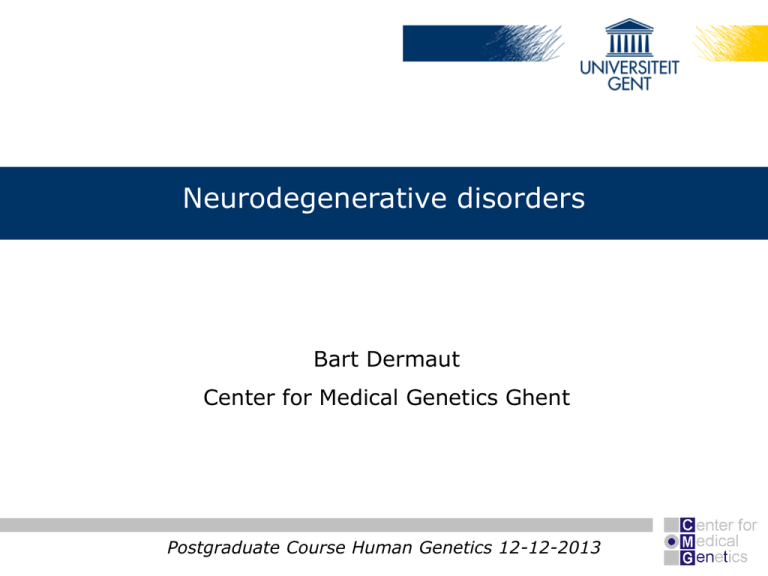Bart Dermaut
advertisement

Neurodegenerative disorders Bart Dermaut Center for Medical Genetics Ghent Postgraduate Course Human Genetics 12-12-2013 Outline Introduction Alzheimer disease (AD) Triplet repeat disorders Diseases of mitochondrial DNA (mt DNA) General introduction Chronic and progressive disorders Selective and symmetric loss of neurons Motor, sensorial and cognitive system Nosological classification following pattern of neuronal loss and disease specific cellular markers AD: PD: ALS: HD: senile plaques, neurofibrillar ‘tangles’ neuronal loss, acetylcholine deficiency Lewy bodies, depletion of dopamine cellular inclusions, axon swelling of motor neurons loss of striatal neurons Martin J.B., NEJM 340:1970-1980 (1999) General introduction Causes Genetic factors -Mendelian inheritance – monogenic: rare familial forms of common disorders classic monogenic e.g. repeat expansion disorder -Multifactorial - common disorders: several genes contribute to disease variation in age of onset and progression point to different pathogenetic mechanisms e.g. AD Environment: toxic or metabolic processes, infection, unknown Outline Introduction Alzheimer disease (AD) Triplet repeat disorders Diseases of mitochondrial DNA (mt DNA) Alzheimer disease Alois Alzheimer (1864-1915) Described AD in 1907 http://www.whonamedit.com/doctor.cfm/177.html 2° lic Biomedische Wetenschappen 2006 - 2007 Alzheimer disease Disease characteristics • adult-onset slow progressive dementia (memory, cognition, personality) • most frequent form of dementia • >60 y: 5-10%, >85 y: 45% • 4 mill/y, 100.000 +/y in US, cost 60 miljard US dollar • 25% of cases familial - mostly late onset - < 2% early-onset familial AD (EOFAD) symptoms always < 65 y 2° lic Biomedische Wetenschappen 2006 - 2007 Alzheimer disease Clinical features • dementia, typically begins with subtle and poorly recognized failure of memory • slowly becomes more severe and, eventually, incapacitating • other common symptoms: anxiety, confusion, poor judgment, language disturbance, agitation, withdrawal, and hallucinations • occasional symptoms: seizures, Parkinsonian features, increased muscle tone, myoclonus, incontinence, mutism • death usually results from general inanition, malnutrition, pneumonia • typical clinical duration of the disease: 8-10 yrs range: 1- 25 yrs 2° lic Biomedischemacroscopic Wetenschappen 2006 - 2007 • post mortem: - microscopic Alzheimer disease Near and connected to hippocampus 2° lic Biomedische Wetenschappen 2006 - 2007 Learning processes, short term memory and conversion to long term memory in other parts (olfactory bulb, amygdala, nucleus basalis) Alzheimer disease - neuropathology Diagnosis/testing histological findings (neuropathological hallmarks) in brain tissue of ß-amyloid (senile) plaques and intraneuronal neurofibrillary tangles 2° lic Biomedische Wetenschappen 2006 - 2007 Alzheimer disease - tau Although tau neurofibrillary tangles appear to be one of the causes of the neuronal degeneration in AD, mutations in the tau gene are associated not withWetenschappen AD, but with2006 another 2° lic Biomedische - 2007 autosomal dominant dementia, FTD Alzheimer disease - genetics mid-80s: • older patients with Down syndrome have neurofibrillary tangles and senile plaques • suggests that extra copies of a gene on chromosome 21 induce the pathologic spectrum of AD finding of a protein fragment, -amyloid, in senile plaques led to cloning of the -amyloid gene -amyloid gene (chromosome 21q21.2): • encodes large protein, amyloid precursor protein (APP) • -, - and -secretases (proteases) split APP in smaller fragments A40 (normal) en A42 (toxic amyloid) 2° lic Biomedische Wetenschappen 2006 - 2007 Alzheimer disease - APP • APP: transmembranary protein -amyloid motif extracellular to the middle of membrane • mutations cause increased production of specific -amyloid fragment (A42) • APP mutations in less than 1% of all early-onset cases 2° lic Biomedische Wetenschappen 2006 - 2007 Alzheimer disease - APP normal AA AA substitutions normal function APP: neuronal survival, neurite outgrowth, synaptic plasticity, cell adhesion 2° lic Biomedische Wetenschappen 2006 - 2007 Alzheimer disease - APP mutations in APP influence proteolytic - and -secretases 2° lic Biomedische Wetenschappen 2006 - 2007 Alzheimer disease - genetics • < 1% of EOFAD caused by APP mutations, other genes ??? • linkage to locus 14q in 50% of all EOFAD!! • positional cloning PS-1 on 14q24.3 • identification PS-2 on 1q31-q42 through sequence homology with PS-1 • mostly missense mutations in PS-1 • two missense mutations in PS-2 • new protein family, transmembranary, 450 AA, 8 transmembranary domains • genomic organization of PS genes is similar (10 exons) 2° lic Biomedische Wetenschappen 2006 - 2007 APOE gene apolipoprotein E variant 4 • • • • • • • 4th locus on 19q involved in late-onset AD homozygotes develop AD 10-20 years earlier than carriers of 2, 3 mainly produced in astrocytes uptake in neurons through LDLR part of LDL particle apolipoprotein E4 increases deposition of -amyloid second modifier on chromosome 10 2° lic Biomedische Wetenschappen 2006 - 2007 2° lic Biomedische Wetenschappen 2006 - 2007 CLU and PICALM associated with AD -CLU (Cx 8): amyloid clearance -PICALM (Cx 11): function in synapses 2° lic Biomedische Wetenschappen 2006 - 2007 CLU and CR1 associated with AD -CLU (Cx 8): amyloid clearance -CR1 (Cx 1): inflammation 2° lic Biomedische Wetenschappen 2006 - 2007 AD – genetic testing Presenile Familial AD Presenilin 1 gene (chr 14) Age: 25-60 y Senile Familial AD Presenilin 2 gene (chr 1) Age: 45-84 y Sporadic AD Inheritance of e4 allele of ApoE gene (chr 19) Age: > 50 y APP gene (chr 21) Age: 40-65 y 2° lic Biomedische Wetenschappen 2006 - 2007 Other genes yet to be identified AD – genetic counseling Genetic counseling • first degree relatives of individuals with sporadic AD have about a 20% lifetime risk of developing AD • presumably, when several individuals in a family have AD, the risk is further increased • EOFAD is inherited in an autosomal dominant manner The risk to offspring of individuals with EOFAD is 50% 2° lic Biomedische Wetenschappen 2006 - 2007 AD genes – therapy Current (symptomatic) therapy • cholinergic replacement (anticholinesterase) Therapies under development • inhibit of -secretases (PS1) • inhibit -secretase • stimulate -secretase • Block immune response • Inhibit fibril formation and disaggegate amyloid - Proteoglycans to inhibit amyloid formation -2°Immunization against -amyloid lic Biomedische Wetenschappen 2006 - 2007 Outline Introduction Alzheimer disease (AD) Triplet repeat disorders - Class I: non-coding repeat, loss of protein function - Class II: non-coding repeat, novel protein function - Class III: coding repeat expansions Diseases of mitochondrial DNA (mt DNA) Triplet repeat expansions 5’UTR coding 3’UTR Dynamic mutations in NDD 10 hereditary NDD have polyglutamine expansions different genes but specific neuropathological characteristics: same pathogenesis ? new paradigm for genetic disease - anticipation repeats in non-coding regions of disease genes 3’ UTR in myotonic dystrophy, 5’ in fragile X mental retardation intronic in Friedreich ataxia (FRDA) putative antisense sequences in SCA8 CAG repeats in coding regions of following disease genes: Huntington disease dentatorubropallidoluysian atrophy (DRLPA) spinal and bulbar muscular atrophy SCA 1,2,3,6,7,12 and 17 Dynamic mutations in NDA often autosomal dominant or X-linked inheritance FRDA: autosomal recessive somatic and germline instability rather prone to expansions than contractions during transmission increase in severity phenotype associated with repeat expansion parental origin can influence degree of anticipation increased risk for anticipation in male carriers exception: FRAXA, FRDA, MD en SCA8 Triplet repeat disease Unique for humans (repeat stable in transgenic mice) Disease Inher Triplet (*) Location Gender bias Nl Unstable Affected Huntington AD CAG exon pat <36 27-35 >35 Fragile X XL CGG 5’UTR mat <60 59-200 (premut) >200 Myotonic dystrophy AD CTG 3’UTR mat <38 38-49 50-2000 (premut) Friedreich ataxia AR AAG intron mat <34 36-100 >100 (*) 64 possible trinucleotide sequences; however only 10 different ones if you take into account permutations (CAG)n=(AGC)n=(GCA)n and reading from either strand 5’(CAG)n=5’(CTG)n Huntington disease (HD) “On Chorea” 1872 – Huntington’s chorea Latin ‘choreus’ = dance Uncontroled, dance-like movements Chorea not obligate, a lot of other features Correct name: Huntington disease (HD) Clinical characteristics progressive disorder with motor, cognitive and psychiatric symptoms (www.genetests.org) first signs mostly in 4° decade movement- and behavioural changes progressive chorea, abnormal eye movements Huntington disease (HD) Clinical characteristics end stage: dementia, personality changes, irritability, depression, hearing loss death due to swallowing problems, infection, suicide… (15-18 y after ‘onset’) juvenile form, first symptoms before age of 20 Huntington disease (HD) – basal ganglia 1. Gyrus cinguli 2. Gyrus frontalis superior 3. Gyrus frontalis medius 4. Gyrus frontalis inferior 5. Corpus callosum 6. Cornu frontale ventriculi lateralis 7. Nucleus caudatus 8. Capsula interna 9. Putamen 10. Polus temporalis 11. Septum pellucidum 12. Corpus striatum 13. Arteria cerebri media 14. Gyri orbitales http://www.neuropat.dote.hu/anastru/anastru.htm Huntington disease (HD) From disease to gene: a long journey… Linkage IT15 gene HD – IT15 gene CAG triplet repeat expansion in coding region, exon 1 10-26 CAGs : normal 27-35 CAGs : intermediary allele, carrier normal, next generation ‘at risk’ 36-39 CAGs : ‘reduced penetrance’, check family history > 40: 40-150 glutamine residues: HD >70 repeats: juvenile HD (children, adolescents) protein: 348 kDa, huntingtin, ubiquitously expressed anticipation: increase of repeats and severity disease in successive generations HD – genetic testing Slipped mispairing mechanism Gain-of function due to CAG repeat mutations Pathogenesis: toxic gain-of-function due to nuclear inclusions Fragile-X syndrome frequent cause of X-linked mental retardation (males) clinical diagnosis: long face with prominent ears, chin, ogival palate; macroorchidism, mild joint hyperlaxity. Behavioural changes in children. MR milder in women than men 1 op 4.000 males. 30% of female mutation carriers: mild to moderate retardation (1/8.000) “fragile site”: chromatine does not condense adequately during meiosis (visible when X chromosome cultured in folium-deficient medium) Fragile-X syndrome FMR1-gene (Fragile-X Mental Retardation-1) (Xq27.3) expanding CGG-repeat in 5’ UTR (promotor region) FMR1 normal alleles: 6-43 CGG premutation alleles: 59-200 CGG. -premutation carriers: normal intelligence full mutation: > 200 CGG -hypermethylation of FMR1 promotor, leading to loss of function -male mutation carriers: Fragile-X syndrome -females: 30% mild to moderate mental retardation and 50%-70% IQ < 85 deletion or point mutation in FMR1, also leading to loss of function FXTAS: Fragile X associated Tremor-Ataxia syndrome FXTAS -25-30% of male carriers premutation: FXTAS -> 50 years -intentional tremor -ataxia -Parkinson-like manifestations -MRI: white matter lesions in cerebellum Fragile-X syndrome vs FXTAS Fragile-X syndrome meiotic instability: maternal transmission premutation > mutation: in female premutation carriers risk of expansion premutation to mutation: ~ number CGG-repeats male premutation carriers: transmission premutation to daughters without expansion (normal transmitting males or NTM) Sherman paradox (anticipation) Fragile X syndrome – genetic testing CGG-repeats meiotically and mitotically unstable Myotonic dystrophy (MD1, Steinert disease) • multisystem disorder • multi-organ involvement: muscles, eye, heart, endocrine system, CNS • variable expression: mild to severe (congenital) mild: classic: cataract and mild myotonia muscle weakness and dystrophy, myotonia, cataract, cardiac conduction abnormalities congenital: severe hypotonia and muscle weakness neonatal respiratory insufficiency with early death mental retardation Myotonic dystrophy CTG expansion in 3’ UTR of DMPK gene: genotype-phenotype correlation Myotonic dystrophy CTG expansion in 3’ UTR of DMPK gene: genotype-phenotype correlation mild form 60 CTG adult form 150 CTG adult form 180 CTG congenital form 2000 CTG juvenile form 500 CTG Myotonic dystrophy- genetic testing Small expansions: PCR; large expansions: Southern blot Outline Introduction Alzheimer disease (AD) Triplet repeat disorders Diseases of mitochondrial DNA (mt DNA) Diseases of mt DNA mitochondrial genome (mt DNA): circular, ds 16.5 kb, intronless, 37 genes, transcription in mitochondria -13 encode enzymes < 5 enzyme complexes involved in oxydative phosphorylation and apoptosis -22 encode tRNAs and 2 rRNA’s necessary for synthesis of these enzymes energy supply (ATP) of nearly all systems dependent of oxydative phosphorylation -mutations in mitochondrial genome: a wide variety of symptoms (pleiotropy) -affect mainly organs that are highly energydependent: brains, skeletal muscles, eye (retina), ears (inner ear), kidney, heart Diseases of mt DNA one mitochondrion: several mt DNA-molecules; most cells: more than 1000 mt DNA-molecules divided over 100 mt; in mature oocytes: number is higher mt DNA: higher mutation frequency than nuclear genome (10 x) cause: no repair mechanisms inheritance: maternal (mt DNA exclusively maternally transmitted) - female with mutation in mt DNA: transmitted to 100% of offspring - male: no transmission of mt DNA mutations Diseases of mt DNA mt DNA mutation: in 1 mt DNA-molecule mitochondrial division: replication of each mt DNA-molecule. At random division of new mt DNA-molecules over new organels cell division: at random division of mitochondria over daughter cells homoplasmy: cell contains same mt DNA-molecules (normal or mutant mt DNA) heteroplasmy: cell contains mixed mt DNA-molecules (normal and mutant) proportion normal/mutant underlies phenotypic expression and variability of mt DNA disorders Genotype-phenotype correlations Mutations in tRNA genes: MELAS Mitochondrial Encephalopathy Lactic Acidosis and Stroke-like lesions Mutation in mitochondrial tRNALeu (3243) Mutations in tRNA genes: MELAS and MERFF mutations leading to MELAS mutation leading to MERFF AD genes – therapy






